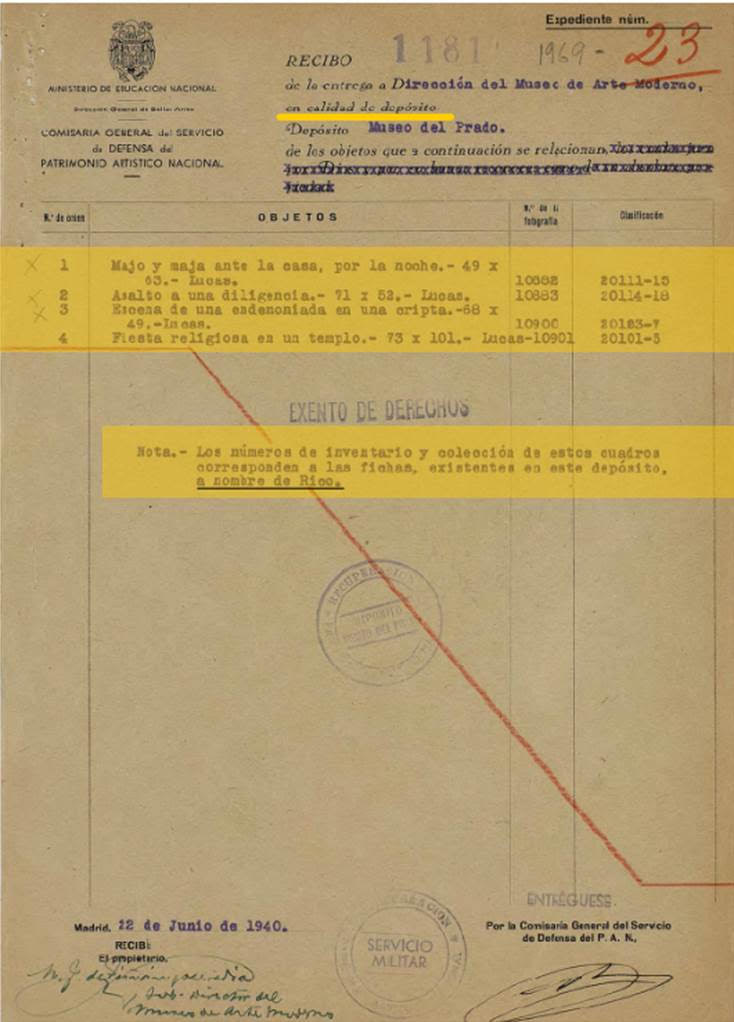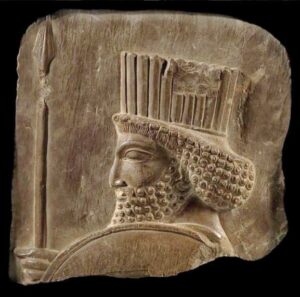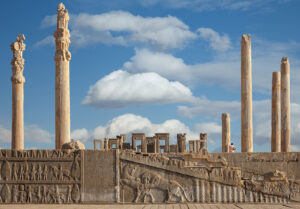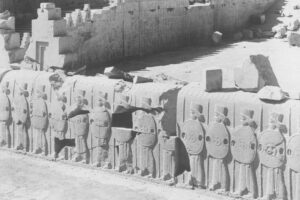by Amineddoleh & Associates LLC | Oct 4, 2022 |
The following guest blog post was written by Andrea Martín Alacid.
 Following other European museums such as the Musée du Louvre in Paris and the British Museum in London, Museo Nacional del Prado (the Prado) in Madrid recently announced a new initiative. It would carry out an ex officio review of its collection to identify works of art seized during the Spanish Civil War and Franco’s regime by the Board of Seizure and Protection of Artistic Heritage founded in 1936 (and known as the Board of Artistic Treasure from 1937 onwards). Following the museum’s initiative, 25 documented works that were never returned to their rightful owners have been identified so far, but there is no doubt that this number could increase.
Following other European museums such as the Musée du Louvre in Paris and the British Museum in London, Museo Nacional del Prado (the Prado) in Madrid recently announced a new initiative. It would carry out an ex officio review of its collection to identify works of art seized during the Spanish Civil War and Franco’s regime by the Board of Seizure and Protection of Artistic Heritage founded in 1936 (and known as the Board of Artistic Treasure from 1937 onwards). Following the museum’s initiative, 25 documented works that were never returned to their rightful owners have been identified so far, but there is no doubt that this number could increase.
In response, the Prado has commissioned Professor Emeritus Arturo Colorado Castellary to lead a research project at the museum with the aim of clarifying the provenance of some of its works. His research will examine the background and context in which the works entered the Prado’s collections, in order to promote transparency and (if necessary and in compliance with all legal requirements) return them to their rightful owners. Professor Colorado is expected to share the first results of his research in early 2023.
 Following the Prado’s announcement and after a great deal of research, this initiative has already borne fruit. The heirs of Pedro Rico López (a lawyer and Republican politician, as well as the mayor of Madrid in the 1930s), have begun the restitution process for the at least 25 paintings thus far. It was not until February 2021 that López’s grandchildren first learned about the whereabouts of their family’s artworks. The works were seized during the post-war period. The heirs eventually learned of the seized assets from an article, El botín del patrimonio español que el franquismo repartió en la posguerra (The spoils of Spanish heritage that Franco´s regime distributed in the post-war period), published in the Spanish national newspaper ABC, after Arturo Colorado’s research came to light . The heirs retained Spanish art law firm Caliope Art Law Boutique, founded by Laura Sánchez Gaona, to set forth their claim.
Following the Prado’s announcement and after a great deal of research, this initiative has already borne fruit. The heirs of Pedro Rico López (a lawyer and Republican politician, as well as the mayor of Madrid in the 1930s), have begun the restitution process for the at least 25 paintings thus far. It was not until February 2021 that López’s grandchildren first learned about the whereabouts of their family’s artworks. The works were seized during the post-war period. The heirs eventually learned of the seized assets from an article, El botín del patrimonio español que el franquismo repartió en la posguerra (The spoils of Spanish heritage that Franco´s regime distributed in the post-war period), published in the Spanish national newspaper ABC, after Arturo Colorado’s research came to light . The heirs retained Spanish art law firm Caliope Art Law Boutique, founded by Laura Sánchez Gaona, to set forth their claim.
As a result of the research carried out by the due diligence department of the law firm, along with the information provided by the Spanish General Directorate of Fine Arts, led by Isaac Sastre de Diego, the current location of 23 of the family’s artworks in various Spanish museums was discovered. In September 2021, members of the Caliope Art Law Boutique accompanied one of the heirs to identify the three Eugenio Lucas paintings in the custody of the Prado. The heirs had previously never seen these works in person. Although this was just a first step, it was an emotional moment for all those present, including Andrés Úbeda de los Cobos (Deputy Director of Conservation and Research) and Carlos Chaguaceda (Director of Communications) working on behalf of the Prado. While viewing the three paintings, it was noted that the Prado kept the Seizure Board’s labels intact. This is most valuable as the label recorded the name of the works’ rightful owner, Pedro Rico.
 The paintings currently held by the Prado, together with the other works documented, have been in the possession of different administrations for a number of decades. Under the law of adverse possession in the Spanish Civil Code, the museums are considered the legal owners. However, the State Attorney General’s Office has recently reevaluated this doctrine in the context of plundered works of art. As a result, the first restitution of a work of art seized during the Civil War took place last month. The recipients are the family of Ramón de la Sota Chalbaud, and the work in question is Portrait of a Young Gentleman by Cornelis can der Voort. This landmark restitution has paved the way for new cases to come.
The paintings currently held by the Prado, together with the other works documented, have been in the possession of different administrations for a number of decades. Under the law of adverse possession in the Spanish Civil Code, the museums are considered the legal owners. However, the State Attorney General’s Office has recently reevaluated this doctrine in the context of plundered works of art. As a result, the first restitution of a work of art seized during the Civil War took place last month. The recipients are the family of Ramón de la Sota Chalbaud, and the work in question is Portrait of a Young Gentleman by Cornelis can der Voort. This landmark restitution has paved the way for new cases to come.
In short, there is no doubt that this initiative by the Prado, together with the re-evaluation of adverse possession, is a crucial and significant step in the restitution procedures of looted cultural heritage in Spain, which unfortunately lack a specific legal framework at this time. It is likely that this framework will be developed in the near future, and we eagerly await ongoing developments.
We congratulate our esteemed colleagues and friends in Spain for their remarkable work fighting for justice and paving the way for equitable restitutions in Europe.
by Amineddoleh & Associates LLC | Jun 3, 2018 |
Note: All of the information in this blog post is taken from a publicly filed document. No confidential or privileged information was used in preparing this post.
 Last month, Assistant District Attorney Matthew Bogdanos petitioned the NY Supreme Court to turn over an Achaemenid limestone bas-relief that had been looted from Iran. Referred to as a “Persian Guard Relief,” the rare object was stolen from Persepolis in 1935. Our founder, Leila A. Amineddoleh, was instrumental in the filing of this case.
Last month, Assistant District Attorney Matthew Bogdanos petitioned the NY Supreme Court to turn over an Achaemenid limestone bas-relief that had been looted from Iran. Referred to as a “Persian Guard Relief,” the rare object was stolen from Persepolis in 1935. Our founder, Leila A. Amineddoleh, was instrumental in the filing of this case.
Persepolis, in current day Iran, is one of the world’s most treasured historical sites, with its name derived from Greek, meaning “Persian city.” Persepolis is considered by UNESCO to have “outstanding universal value.” UNESCO describes Persepolis as “magnificent ruins…among the world’s greatest archaeological sites… among the archaeological sites which have no equivalent and which bear unique witness to a most ancient civilization.” In 1931 excavations were begun at the site, and UNESCO declared the ruins a World Heritage Site in 1979.

Persepolis
© BornaMir/iStock.com
The ancient city, dating back to at least 515 B.C., was the capital of the Achaemenid Empire. Persepolis was built in terraces up from the river Pulwar to rise on a larger terrace of over 125,000 square feet, partly cut from a mountain. Darius I began construction of the site, and it developed until the Greeks plundered and razed the city under the leadership of Alexander the Great in 333 BC (purportedly in retribution for the destruction of the Parthenon by the Persians in 480 BC). The city was widely known as spectacular and breath-taking. As part of the site, Darius I built a palace known as the “Apadana,” used for official audiences. The looted relief at issue was stolen from this great hall.
The looted limestone bas-relief was stolen from Persepolis in 1935, during official excavations completed by the Oriental Institute at the University of Chicago. Authorities were alerted to the theft, and the Iranian government attempted to find and recover the piece, but it disappeared and entered the global black market, eventually making its way into a Canadian museum. Decades later, it was stolen from the museum, recovered, and then appeared at TEFAF in New York in the fall of 2017. At that point, the work was seized by the NY District Attorney’s Office after they learned of the work’s illicit origins. Our founder, Leila Amineddoleh, had informed authorities about the piece after learning about its plundered past by Dr. Lindsey Allen, Lecturer in Greek & Near Eastern History at King’s College in London. As the result of several years examining fragmentary reliefs from the site in museums around the world, and searching archives for their histories, Dr. Allen suspected the relief was looted. When Wace exported the relief for TEFAF, Dr. Allen contacted Ms. Amineddoleh, and explained why she thought the work was stolen.
Iran safeguards Persepolis due to its historic significance. In fact, Iran protects all of its cultural heritage, with the nation’s first patrimony laws passing in 1930. Because of these laws, there is no way that the relief left Iran legally, absent permission from the cultural ministry. Ms. Amineddoleh served as an expert to the District Attorney’s Office in advising on the relevant cultural heritage laws.

The eastern stairs at the Apadana in 1933.
(Photo: The Oriental Institute of University of Chicago, Photo 23188/ Neg.Nr. 12822
https://oi-idb.uchicago.edu/id/bec348b2-7e3c-49fd-8fd6-e9f057c92c4e)
The District Attorney’s Office submitted its turnover request on May 24 (read the document HERE: 18-05-24 PGR Motion for Turnover-reduced), but the case may carry on for some time. The limestone relief, part of an historical complex, has significance not only to the people of Iran, but to archaeologists and classicists, and to anyone visiting Iran’s most celebrated archaeological site. The limestone relief’s theft from Persepolis was tragic and damaging to the site, and hopefully the limestone guard will return to his home protecting the ancient site. The guards are designed to work in the site as a collective, not as individuals. Their fragmentation removes their context, and high-profile sales make other Achaemenid ruins potentially vulnerable to plunder.
by Amineddoleh & Associates LLC | Feb 21, 2017 |
On Sunday, the New York Times published an insightful article, “Has the Art Market Become an Unwitting Partner in Crime?,” examining how anonymity and shell companies have affected the commercial art market.
Mr. Bowley’s and Mr. Rashbaum’s piece provide an overview of how anonymity in art transactions have facilitated scandals including the forgery scheme that took down the Knoedler Gallery, the ongoing dispute between Russian billionaire collector Dmitry E. Rybolovlev and his one-time buyer Yves Bouvier, and the United States’ recent allegations that Malaysian government officials have allegedly embezzled more than $1 billion in public funds (and allegedly spent $130 billion of those laundered funds purchasing artwork at auction).
Of course, anonymity in the art market can provide buyers and sellers of artworks with privacy and security from theft. But as all these recent cases indicate that the same anonymity of offshore accounts and shell companies can also facilitate tax evasion and hiding assets both from the government and occasionally spouses, as was allegedly in the Dmitry Rybolovlev case.
Much of the increased scrutiny on the anonymous purchase and laundering of major artworks was catalyzed by last year’s release of the “Panama Papers,” a collection of more than 11 million files that were leaked by a German newspaper in April 2016. The documents, so-named for the Panamanian law firm that held the documents, exposed how offshore shell companies have been popularly utilized to conceal art ownership and facilitate tax evasion and money laundering. The Times article reiterates some of the same issues I have previously discussed about the use of shell companies to launder artworks when the Panama Papers story first broke.
The Times article provided a few examples of recent efforts to increase transparency such as the Treasury Department’s new initiatives in finance and real estate to more closely monitor the identity of holders of high-net worth property and shell companies. Christie’s has also announced that it will now require agents seeking to sell artworks through the auction house to disclose the owner’s identity. It will be interesting to see whether Sotheby’s and other commercial auction houses will follow Christie’s lead. Such changes could potentially have a significant impact on the use of artworks in international money laundering schemes.
Read the New York Times article here.
 Following other European museums such as the Musée du Louvre in Paris and the British Museum in London, Museo Nacional del Prado (the Prado) in Madrid recently announced a new initiative. It would carry out an ex officio review of its collection to identify works of art seized during the Spanish Civil War and Franco’s regime by the Board of Seizure and Protection of Artistic Heritage founded in 1936 (and known as the Board of Artistic Treasure from 1937 onwards). Following the museum’s initiative, 25 documented works that were never returned to their rightful owners have been identified so far, but there is no doubt that this number could increase.
Following other European museums such as the Musée du Louvre in Paris and the British Museum in London, Museo Nacional del Prado (the Prado) in Madrid recently announced a new initiative. It would carry out an ex officio review of its collection to identify works of art seized during the Spanish Civil War and Franco’s regime by the Board of Seizure and Protection of Artistic Heritage founded in 1936 (and known as the Board of Artistic Treasure from 1937 onwards). Following the museum’s initiative, 25 documented works that were never returned to their rightful owners have been identified so far, but there is no doubt that this number could increase. Following the Prado’s announcement and after a great deal of research, this initiative has already borne fruit. The heirs of Pedro Rico López (a lawyer and Republican politician, as well as the mayor of Madrid in the 1930s), have begun the restitution process for the at least 25 paintings thus far. It was not until February 2021 that López’s grandchildren first learned about the whereabouts of their family’s artworks. The works were seized during the post-war period. The heirs eventually learned of the seized assets from an article, El botín del patrimonio español que el franquismo repartió en la posguerra (The spoils of Spanish heritage that Franco´s regime distributed in the post-war period), published in the Spanish national newspaper ABC, after Arturo Colorado’s research came to light . The heirs retained Spanish art law firm Caliope Art Law Boutique, founded by Laura Sánchez Gaona, to set forth their claim.
Following the Prado’s announcement and after a great deal of research, this initiative has already borne fruit. The heirs of Pedro Rico López (a lawyer and Republican politician, as well as the mayor of Madrid in the 1930s), have begun the restitution process for the at least 25 paintings thus far. It was not until February 2021 that López’s grandchildren first learned about the whereabouts of their family’s artworks. The works were seized during the post-war period. The heirs eventually learned of the seized assets from an article, El botín del patrimonio español que el franquismo repartió en la posguerra (The spoils of Spanish heritage that Franco´s regime distributed in the post-war period), published in the Spanish national newspaper ABC, after Arturo Colorado’s research came to light . The heirs retained Spanish art law firm Caliope Art Law Boutique, founded by Laura Sánchez Gaona, to set forth their claim. The paintings currently held by the Prado, together with the other works documented, have been in the possession of different administrations for a number of decades. Under the law of adverse possession in the Spanish Civil Code, the museums are considered the legal owners. However, the State Attorney General’s Office has recently reevaluated this doctrine in the context of plundered works of art. As a result, the first restitution of a work of art seized during the Civil War took place last month. The recipients are the family of Ramón de la Sota Chalbaud, and the work in question is Portrait of a Young Gentleman by Cornelis can der Voort. This landmark restitution has paved the way for new cases to come.
The paintings currently held by the Prado, together with the other works documented, have been in the possession of different administrations for a number of decades. Under the law of adverse possession in the Spanish Civil Code, the museums are considered the legal owners. However, the State Attorney General’s Office has recently reevaluated this doctrine in the context of plundered works of art. As a result, the first restitution of a work of art seized during the Civil War took place last month. The recipients are the family of Ramón de la Sota Chalbaud, and the work in question is Portrait of a Young Gentleman by Cornelis can der Voort. This landmark restitution has paved the way for new cases to come. Last month, Assistant District Attorney Matthew Bogdanos petitioned the NY Supreme Court to turn over an Achaemenid limestone bas-relief that had been looted from Iran. Referred to as a “Persian Guard Relief,” the rare object was stolen from Persepolis in 1935. Our founder, Leila A. Amineddoleh, was instrumental in the filing of this case.
Last month, Assistant District Attorney Matthew Bogdanos petitioned the NY Supreme Court to turn over an Achaemenid limestone bas-relief that had been looted from Iran. Referred to as a “Persian Guard Relief,” the rare object was stolen from Persepolis in 1935. Our founder, Leila A. Amineddoleh, was instrumental in the filing of this case.
